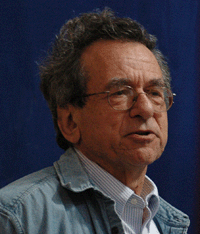Alma mater Harvard University | Role Physicist Name David Mermin Fields Physicist | |
 | ||
Institutions Cornell University
University of California, San Diego
University of Birmingham Known for Mermin–Wagner theorem
Mermin–Ho relation
Lindhard–Mermin dielectric function
Coining the term 'boojum'
Mermin–Peres magic square Notable awards Lilienfeld Prize (1989)
National Academy of Sciences (1991)
Klopsteg Memorial Award (1994)
Majorana Prize (2010) People also search for Neil Ashcroft, Charles Kittel, H. Ibach, H. Lüth Awards Guggenheim Fellowship for Natural Sciences, US & Canada Books Quantum Computer Science, It's about Time: Understa, Boojums all the way through, Space and Time in Special R Profiles | ||
Residence United States of America Education Harvard University (1961) | ||
Spooky Actions At A Distance?: Oppenheimer Lecture
Nathaniel David Mermin (; born 1935) is a solid-state physicist at Cornell University best known for the eponymous Mermin–Wagner theorem, his application of the term "Boojum" to superfluidity, and for the quote "shut up and calculate!" (in the context of the interpretation of quantum mechanics).
Contents
In 1976, Neil Ashcroft and Mermin published a textbook on solid-state physics.
As a proponent of Quantum Bayesianism, Mermin described the concept in Nature.
In 2003, the journal Foundations of Physics published a bibliography of Mermin’s writing that included three books, 125 technical articles, 18 pedagogical articles, 21 general articles, 34 book reviews, and 24 "Reference Frame" articles from Physics Today.
Mermin's foot
Mermin has contributed to special relativity with two books and several articles. In It's About Time (2005) he suggests that the English foot (0.3048 meters) be slightly modified:
Henceforth, by 1 foot we shall mean the distance light travels in a nanosecond. A foot, if you will, is a light nanosecond (and a nanosecond, even more nicely, can be viewed as a light foot). …If it offends you to redefine the foot … then you may define 0.299792458 meters to be 1 phoot, and think "phoot" (conveniently evocative of the Greek φωτος, "light") whenever you read "foot".This adaptation of a physical unit is one of several ploys that Mermin uses to draw students into space-time geometry.
